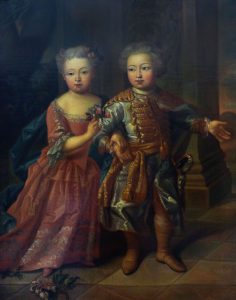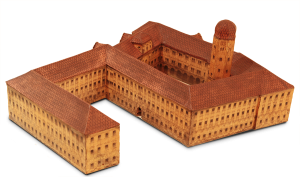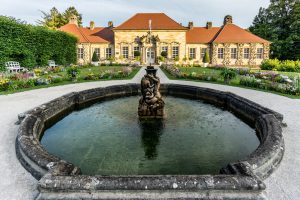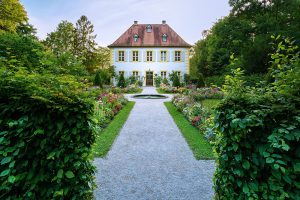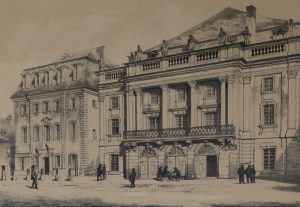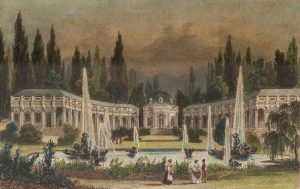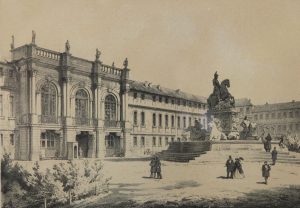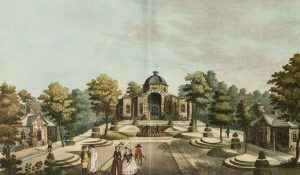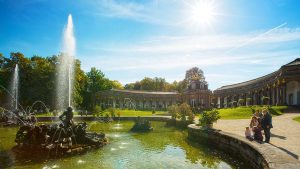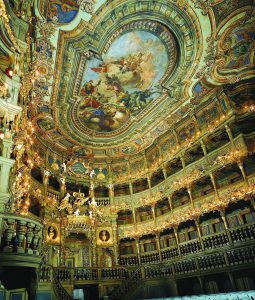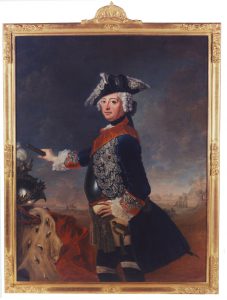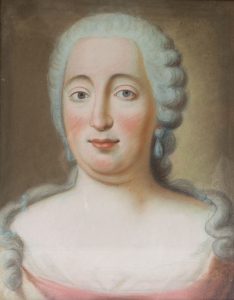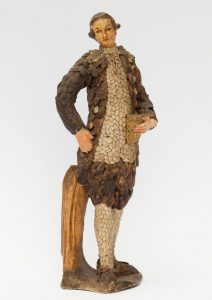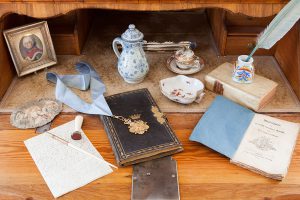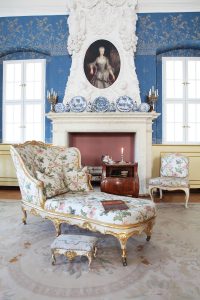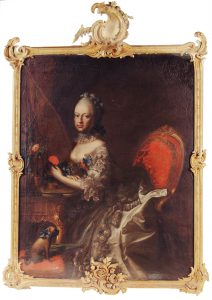Wilhelmine about herself
My heritage and dynasty
As a daughter of King Frederick William I of the most celebrated House of Hohenzollern, and his esteemed wife Sophia Dorothea of Hanover, I am entitled to be addressed as “Your Royal Highness”. And, born in 1709 as the elder sister of my beloved brother Frederick, younger than myself by two years, and cherished not only by myself but all around the world, where he is rightly named the “Great”, I rank higher than all of my sisters. Yet still, the lofty aspirations of my ambitious mother, to marry me to the heir of the throne of England, and thus make me Queen of England, failed miserably.
My arrival in Bayreuth
Instead of becoming Queen of England, in 1731 I found myself in Bayreuth, married to the crown prince Frederick, a fairly acceptable match at least, but son of the extremely unpleasant prince George Frederick Charles, Margrave of Brandenburg-Bayreuth. My first impression of this utterly provincial principality was one of shock. Most modest were our dwellings in the shabby old palace, until, in 1732, we were finally relieved of my father-in-law, the old miser and drunkard.
How I made my impression on Bayreuth
After my father-in-law had passed away, and my husband had succeeded him, from 1735 onwards I found myself, with my husband’s support, in a position to convert the sleepy town of Bayreuth into a veritable princely residence. My summer residence, the “Eremitage”, or Hermitage, for example, was built in exact accordance with my very own ideas, generous and splendid, but at the same time a place to withdraw to and sink into creative contemplation.
Finally, in 1748 I was able to inaugurate my most precious work of architecture. The opera house,
constructed and decorated by the best – and not inexpensive – master builders of my day, Saint-Pierre and Galli Bibiena, was glamorously inaugurated on the occasion of the wedding of, and in honour of my daughter Fredericka. How my subjects in Bayreuth admired my husband and myself, when we made our way there to watch the glamorous operas staged there! And even if they did moan now and then about the immense expenses they had to shoulder, how proud their descendants are now that I have bequeathed them a world cultural heritage sight. In the very same year, with the enchanting rock
garden of Sanspareil, not far from Burg Zwernitz, I proved that I was, with little effort, able to transform my knowledge of the Chinese and the ancient Occidental world into a stone witness of my thinking. For Frederick, however, Sanspareil was merely a location to pursue his passion for hunting. On our way there we always had the opportunity to refresh ourselves pleasantly in the attractive little palace in Birken, belonging to my minister, Baron von Stein. After we lost the Old
Palace to a most unwelcome fire, it was a pleasure for me to draw up the plans for my palace myself. Despite my relatively limited funds, I succeeded here – as with the opera house – in competing with the architecture of my regal place of origin, and in turning Bayreuth into a gleaming jewel of stately architecture, which, I predict, will still attract hoards of visitors in 250 years to come.
My passion for the fine arts
My masterpieces of architecture were intended to convey a glittering impression to the outside world. My passion, however, was divided between music, art and literature. In the Hermitage I wrote my memoirs, in which I ruthlessly settled my scores with the harsh upbringing methods used by my father, the lofty marriage plans my mother held for me, and the cold haughtiness of my beloved brother after his ascension to the throne. And yet, Frederick and I continued to write each other intimate letters, in which we philosophised and moaned about all the world and his wife, and
exchanged our thoughts on musicians and authors. And even the greatest of all them all, the great Enlightener Voltaire, exchanged a lively correspondence with me, in which I called on him to settle his differences with Frederick and he expressed his desire for me to be instrumental in bringing about peace between France and Prussia. I allowed his tragedy Sémiramis to inspire me to write an opera, in which the rays of the enlightenment shine as brightly as in my thoroughly philosophical opera L’Huomo, which was performed in June 1754 to honour my brother’s visit to Bayreuth one year later. Renowned female figures from the ancient world, such as Semiramis and Cleopatra are the 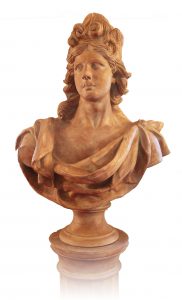 favourite subjects of the paintings that I have collected with just as much passion as the ancient sculptures which I acquired myself on a journey to Italy. I was obliged to bequeath this part of my estate to my brother in Berlin in my last will and testament, however, meaning that they can only be admired by visitors there. I dabbled in painting, in the best sense of the word, and devoted myself to famous female figures of the ancient worlds, like Cleopatra and Lucretia, tragic victims to whom I felt I could relate.
favourite subjects of the paintings that I have collected with just as much passion as the ancient sculptures which I acquired myself on a journey to Italy. I was obliged to bequeath this part of my estate to my brother in Berlin in my last will and testament, however, meaning that they can only be admired by visitors there. I dabbled in painting, in the best sense of the word, and devoted myself to famous female figures of the ancient worlds, like Cleopatra and Lucretia, tragic victims to whom I felt I could relate.
My political ambitions
When my husband assumed rule in Bayreuth in 1735, I, as a daughter of a king, certainly did not plan to become a victim, but rather intended to take action, and share his reign – an intention which quickly escalated to our first
marital quarrel. This did not however deter me from intervening again, to serve my little margraviate, which
was positively wedged in between the great powers of Prussia, Austria and France. And thus I came to actively support my husband in his to and fro policies during the two Silesian Wars and the Seven Years’ War – often to the displeasure of my royal brother. In 1743 I made a lasting impression on educational policy by founding the University in Erlangen, found in Superville its first chancellor, and – outrageously – personally set the professors current and highly controversial philosophical and religious theses on the capacity of thinking as topics for the inaugural disputation.
My journey to Italy
It has come to my ears, not only that my memoirs have been published against my will, but also my chronicles
from a journey which took me to France and Italy in 1754/55. How fortunate that I did not even entrust the real reasons behind the journey to my diary! My subjects knew only of a vacation in Montpellier. In actual fact I met with influential politicians in both France and Italy, and even held secret negotiations with the Vatican in the run-up to the Seven Years’ War, to finally prove for once and for all to my brother Frederick, that was well capable of demonstrating political acumen. The fact that I returned home with more ancient art that political results is a different matter altogether.
On my private life
Finally, I will allow you an insight into my affections. That my favourite little court maiden stole the heart of my husband is bad enough. That she not only shared his bed, but also intended to take my place as his political adviser, that went too far: I was forced to remove her from court. As far as I myself am concerned, I categorically deny any rumours regarding alleged intimate relationships to people like Katte, a friend of my brother’s, or even
to a Bayreuth Privy Councillor. This is the absolute truth, as true as everything recorded in my memoirs. And finally, it remains for me to rectify a small matter. Of course I was fond of my little lap dog, Folichon, just as my brother was of his. When we had our dogs send love letters to each other, however, it was purely a literary exercise or game, which had no relevance either to our feelings or the feelings of our little dogs.
Translation: Rona McGeoch

